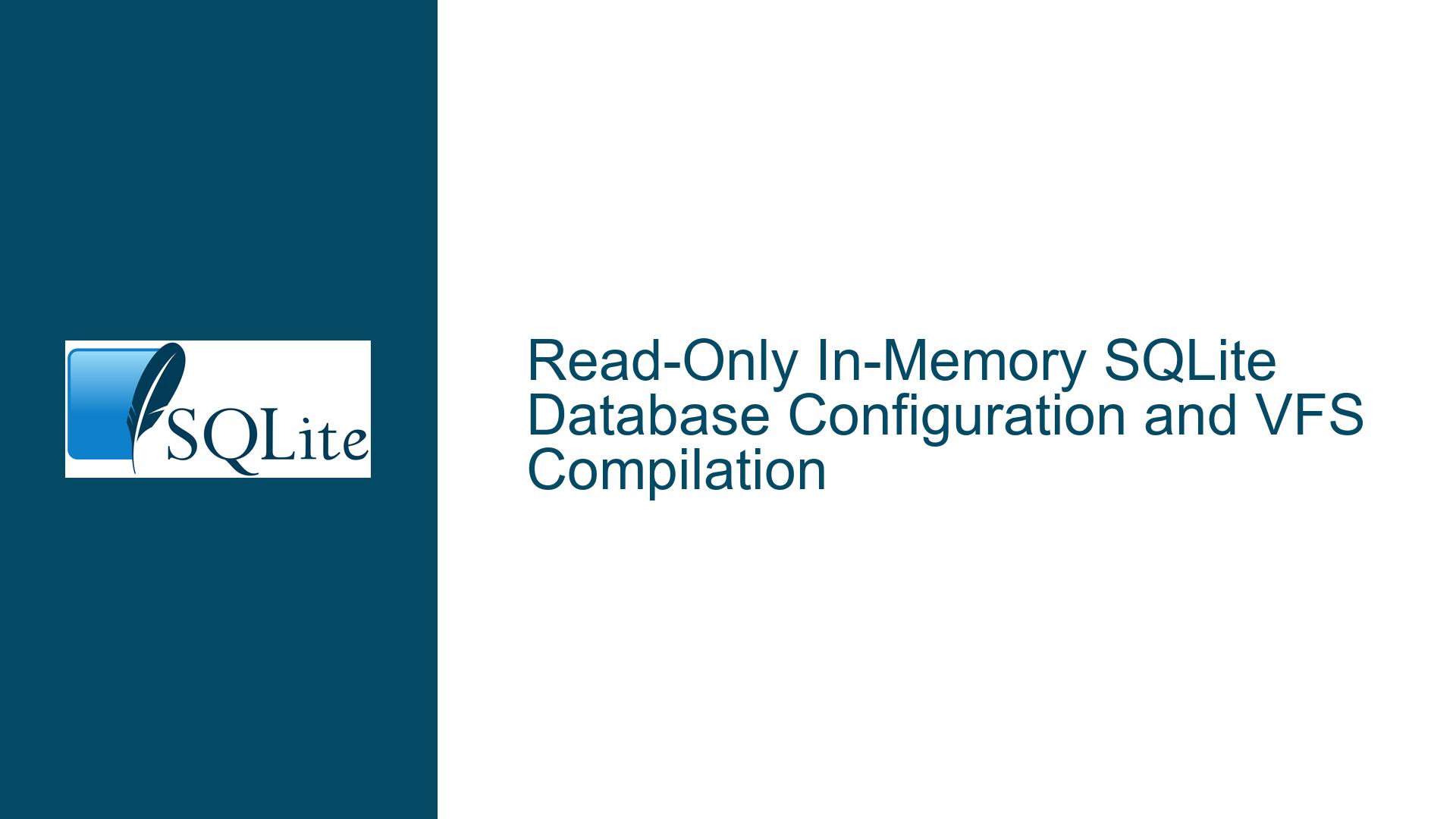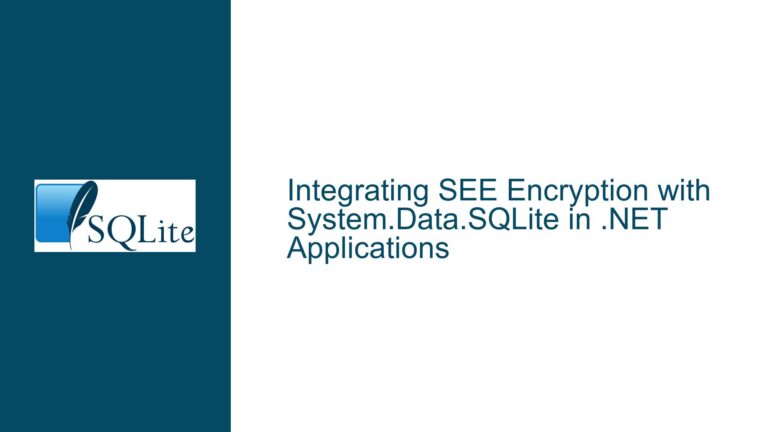Read-Only In-Memory SQLite Database Configuration and VFS Compilation
Understanding the Conflict Between Read-Only Mode and In-Memory Database Behavior
The concept of a read-only in-memory SQLite database raises fundamental questions about the interaction between persistence models and access control mechanisms. SQLite’s architecture treats in-memory databases as transient entities by default, existing only during the lifespan of a connection and without built-in access restrictions. However, advanced use cases demand configurations where an in-memory database acts as a shared resource with controlled read-only access for secondary connections. This requires careful coordination of URI parameters, virtual file system (VFS) layers, and compile-time options.
The core challenge lies in reconciling two seemingly contradictory requirements:
- Ephemeral Storage: In-memory databases are designed to vanish when the last connection closes, making them inherently mutable within their lifecycle.
- Access Restrictions: Read-only mode enforces immutability, preventing modifications to schema or data.
When a user attempts to enforce read-only mode on an in-memory database using URI parameters like mode=ro, SQLite’s internal logic faces ambiguity. The database engine must decide whether to prioritize the transient nature of in-memory storage or the access restrictions. By default, SQLite prioritizes the former, leading to configuration conflicts unless specific VFS components and connection sequencing are employed.
Critical Factors Preventing Read-Only In-Memory Database Initialization
Misconfigured URI Parameters and Ambiguous Syntax
A primary source of failure stems from incorrect URI formatting when combining mode=memory with mode=ro. SQLite’s URI parser processes parameters sequentially, and duplicate mode keys override each other. The syntax mode=(memory,ro) is invalid because SQLite does not support tuple-style parameter values in URIs. This results in the database engine interpreting only one mode directive, typically defaulting to the last specified value.
For example, the URI file:mem?mode=memory&cache=shared&mode=ro is parsed as:
mode=memory(initial declaration)cache=sharedmode=ro(overrides previous mode)
The final interpretation becomes mode=ro without mode=memory, causing SQLite to attempt opening a read-only file-based database named "mem" instead of an in-memory instance. Similarly, mode=(memory,ro) is treated as an unrecognized string, leading to fallback behavior.
Absence of memdb VFS in Standard Builds
The memdb VFS (Virtual File System) is a specialized module enabling named in-memory databases with extended capabilities, including read-only access from secondary connections. However, this component is not included in standard SQLite amalgamation builds or precompiled binaries distributed with operating systems. Attempting to reference vfs=memdb without a custom-compiled SQLite library triggers a "no such VFS" error, as the module remains unavailable unless explicitly enabled during compilation.
Compile-Time Exclusion of Deserialization Features
SQLite’s build system allows disabling non-essential features via preprocessor macros. The SQLITE_OMIT_DESERIALIZE flag excludes code related to database deserialization and the memdb VFS. If this macro is defined during compilation, the memdb module becomes inaccessible, rendering URIs that reference it unusable. Many third-party SQLite distributions (e.g., those bundled with programming languages like Python) omit deserialization support to reduce binary size, inadvertently blocking this functionality.
Resolving Read-Only In-Memory Database Configuration Errors
Step 1: Validate URI Syntax and Parameter Hierarchy
Begin by constructing URIs that avoid conflicting mode declarations. Use distinct parameters to specify the database type and access mode:
file:sharedmem?cache=shared&vfs=memdb&mode=ro
This URI:
- Names the in-memory database
sharedmem - Enables shared cache (
cache=shared) - Selects the
memdbVFS (vfs=memdb) - Sets read-only access (
mode=ro)
Ensure that the vfs and mode parameters are placed after the database name to prevent parsing ambiguities.
Step 2: Verify memdb VFS Availability
Check whether the current SQLite environment supports the memdb VFS by executing:
PRAGMA compile_options;
Search for DESERIALIZE in the output. If SQLITE_OMIT_DESERIALIZE appears, the VFS is unavailable. Alternatively, attempt to open a named in-memory database with:
import sqlite3
conn = sqlite3.connect("file:/tempdb?vfs=memdb", uri=True)
A successful connection indicates memdb support; an OperationalError confirms its absence.
Step 3: Compile SQLite with memdb and Deserialization Support
Download the SQLite source code from the official website. Configure the build process to include the memdb VFS by ensuring SQLITE_OMIT_DESERIALIZE is not defined. Use the following compilation steps:
wget https://www.sqlite.org/src/tarball/sqlite.tar.gz
tar xzf sqlite.tar.gz
cd sqlite
./configure CFLAGS="-DSQLITE_ENABLE_DESERIALIZE"
make
sudo make install
This compiles SQLite with deserialization capabilities, enabling the memdb VFS.
Step 4: Establish Primary and Secondary Connections Correctly
In-memory databases configured with memdb require a primary read-write connection before secondary read-only connections can access them. Follow this sequence:
- Primary Connection (Read-Write):
primary_conn = sqlite3.connect("file:/shareddb?vfs=memdb", uri=True)
primary_conn.execute("CREATE TABLE data (id INTEGER PRIMARY KEY, content TEXT)")
- Secondary Connection (Read-Only):
secondary_conn = sqlite3.connect("file:/shareddb?vfs=memdb&mode=ro", uri=True)
cursor = secondary_conn.execute("SELECT * FROM data") # Succeeds
secondary_conn.execute("INSERT INTO data VALUES (1, 'test')") # Fails with "attempt to write a readonly database"
Step 5: Alternative Approaches Without memdb VFS
If recompiling SQLite is impractical, use shared cache mode with careful connection ordering:
- Primary Connection (Read-Write):
primary_conn = sqlite3.connect("file:memdb?mode=memory&cache=shared", uri=True)
- Secondary Connection (Read-Only):
secondary_conn = sqlite3.connect("file:memdb?mode=ro&cache=shared", uri=True)
This leverages SQLite’s shared cache mechanism to allow multiple connections to the same in-memory database. However, this method is less robust than memdb VFS, as the database name (memdb) is fixed and not user-definable.
Step 6: Database Lifetime Management
To prevent premature deletion of the in-memory database, ensure at least one read-write connection remains open while read-only connections are active. Use connection pools or background threads to maintain the primary connection’s lifespan.
Step 7: Cross-Process Read-Only Access
For read-only access across processes, serialize the in-memory database to a byte array and reload it into a file-based read-only database:
# In primary process
primary_conn = sqlite3.connect(":memory:")
# ... populate data ...
data = primary_conn.execute("SELECT writefile('snapshot.db', dbfile) FROM (SELECT writefile() AS dbfile)").fetchone()
# In secondary process
secondary_conn = sqlite3.connect("file:snapshot.db?mode=ro", uri=True)
This workaround sacrifices in-memory performance for cross-process compatibility without requiring memdb VFS.
By systematically addressing URI syntax errors, VFS availability, and connection sequencing, developers can successfully implement read-only in-memory databases in SQLite. The solution requires either custom SQLite builds with memdb support or careful use of shared cache mode, depending on deployment constraints.






